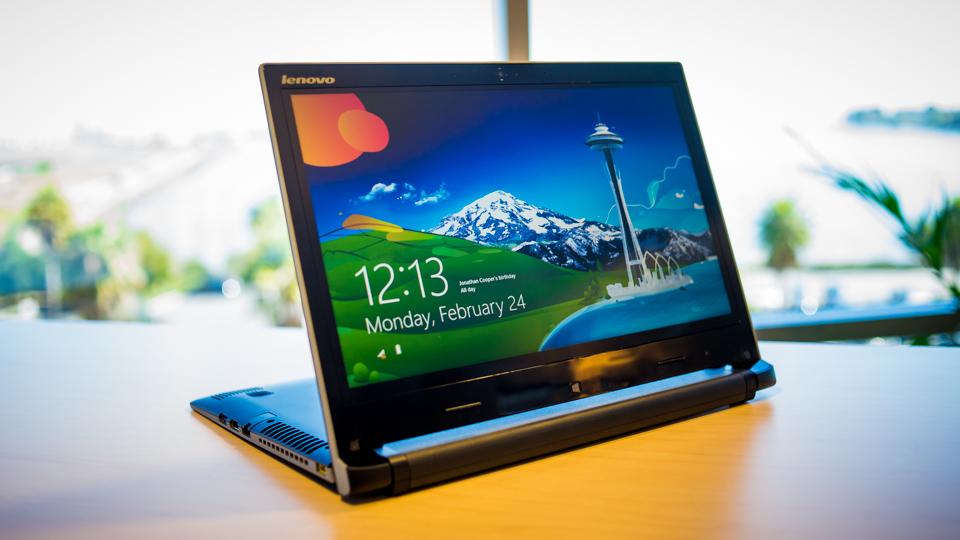Why you can trust TechRadar
Lenovo bills the Ideapad Flex 14 as an entry-level laptop that offers some of the bells and whistles of more expensive portables. For a $999 device with similar specifications to higher-end systems like Lenovo's Yoga 2 Pro, this feels like an accurate claim, and an appealing one as well.
To achieve such a low-price point, a few compromises were necessary. Our perspective is that power and performance should be the last sacrifices made for the maximum long-term satisfaction of any computer, and this is precisely what Lenovo has done here.
We liked
For it's affordable price tag, we like a whole lot about the Flex 14. First and foremost, the system packs solid power and performance via Intel's Core i5 4200U processor into an attractive - if basic-looking - package. The battery life is particularly impressive because it actually feels possible that a student could carry this thing around all day without ever needing to plug in. It definitely passes the cross-country flight test in this regard.
One of the nice things about Lenovo's current laptop line-up is the high-quality keyboard that the manufacturer uses for its system. The Flex 14 is no different - this system is a joy to type on. The mousepad is no different. Although the fact that it travels a bit more than other pads upon clicking may be off-putting to some, we find it surprisingly close in responsiveness to the trackpad Apple uses in its MacBooks.
I also like the sound quality, and the ability to place this laptop into a touch-oriented stand mode while watching videos or listening to music.
Finally, we like that the Flex 14 has a built-in Ethernet access, thanks to a clever port implementation on the left side of the system.
We disliked
Without a doubt, the Flex 14's greatest weakness is the quality of its display. We can appreciate the need to cut corners in a budget system, but it doesn't make the absence of 1080p resolution any less surprising. In similar fashion, the poor viewing angles also stand out...in a bad way.
I really disliked the absence of a backlit keyboard, which feels like a big deal at this price point. So many of us operate our laptops in dark and low-light conditions these days, this omission will almost certainly annoy everyone at some point in time.
The overall build of the Flex 14 is somewhat suspect. While it looks good, and I'm not expecting a metal body at this price, the plastic is bendy and gives more than I'd like when I press the trackpad. It might be called the Flex, but it shouldn't flex this much.
Finally, while we appreciated the relative snappiness the 128GB SSD in our review unit provided in regards to overall performance, I'm left wondering if this will be enough disk space for users looking to store large quantities of photos, music, or videos on their laptop. Thankfully, Lenovo does offer a 500GB mechanical configuration—and at a lower price-point to boot. A 256GB SSD is also available for more money.
Final Verdict
While the screen quality will disappoint video junkies, it doesn't feel like a deal breaker for the most common users of the Flex 14: students and users interested in a common, everyday device for straightforward computing needs. At its most basic, this system is affordable, comfortable to use for long stretches of time, and - most importantly - makes no compromises around performance.
Reviewing laptops for TechRadar can make it easy to become so accustomed to hyper-HD IPS displays and extravagant performance that it's easy to forget how important and popular the budget sector is. After spending a week using the Flex 14 full time, we found ourselves pleased with the caliber of performance offered at this price point. Truth be told, on a day-to-day basis performing common tasks, it was hard to detect any discernable difference between this system and far more expensive ones - gaming of course, is a whole other matter.
This, in combination with the high-quality keyboard, the touch screen, and the remarkable battery life makes it easier to recommend this laptop.
And what to make of the Flex 14's namesake flexibility? Ultimately, it's a bonus perk for users, who will likely find themselves using this device in stand mode far
